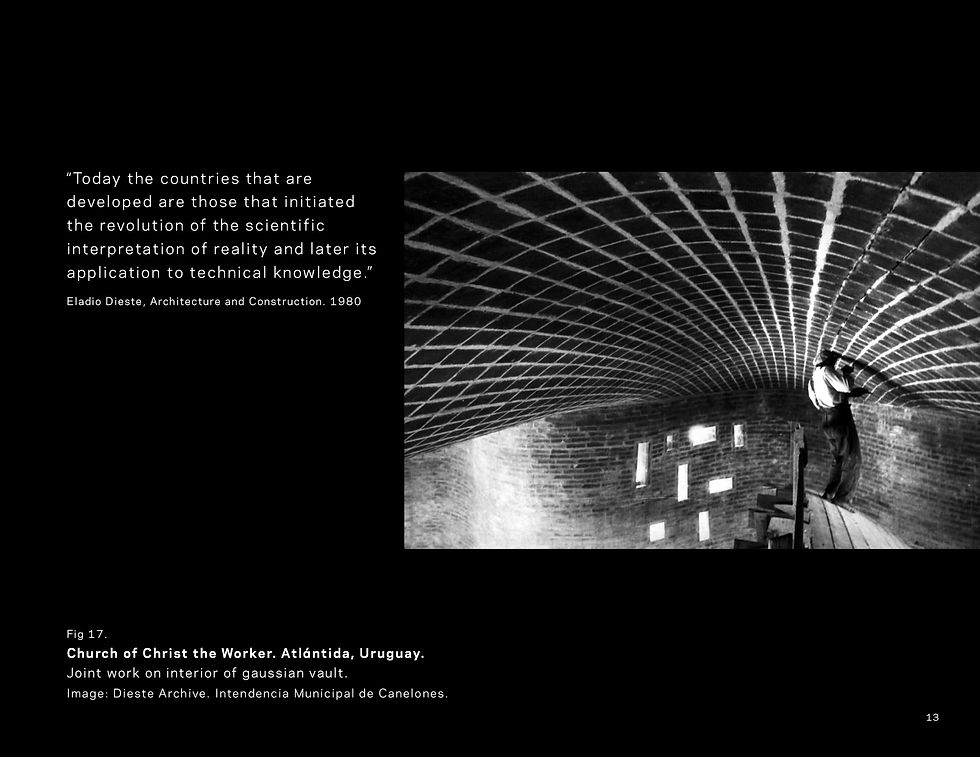Today, the countries that are developed are those that initiated the revolution of the scientific interpretation of reality and later its application to technical knowledge. This is what we call the Industrial Revolution…it took place with such great injustice that the repercussions from the fierce indignation that its inequities produced in mankind are the reason for the destructive madness that has spread throughout the world. 1
- Eladio Dieste
The onset of the Industrial Revolution in the eighteenth centur y made the selection of building materials highly political. Building methods transitioned from assemblie s based in masonry and wood to include newly developed materials like iron, steel, and reinforced conc rete. Previous building methods had relied on trial and error. After the Industrial Revolution, “engineer s had at their disposal building methods that could be gauged with security, rather than by trial and error. These methods replaced long and imprecise processes with new forms of rapid analysis.” 2 This shift affected the selection of building materials throughout the building industry and specifically impacted Rafa el Guastavino (1842-1908) and Eladio Dieste (1917-2000), who both worked with masonry.
Rafael Guastavino Moreno arrived in the United States in 1881 w ith his son, Rafael Jr. Trained as a master builder in Spain, Guastavino gained notoriety in the architectu ral community by implementing thin tile vaulting techniques. He established the Guastavino company in the late 1880’s and after decades of success, work began to decline in the 1930’s. The “Modern Architecture: International Exhibition”, held at the recently opened Museum of Modern Art in 1932 exhibited work that looked upon steel and reinforced concrete as the favored materials and assembly systems. Further , building codes that standardized building methods, resulted in the Guastavino Company’s reluctan t submission to structural engineers as they were told how to size their own structures. In the United States, this was “an age which recognized licensed engineers rather than master builders as the authorita tive figures of construction.” 3 The Guastavino Company officially closed their doors in 1962.
As the Guastavino Company’s work declined in the United States, Eladio Dieste began his career as an architect/engineer in Uruguay. In the early 1940’s, Dieste stu died graphic statics as well as numerical methods for engineering calculations at the Facultad de Ingenie ría de Montevideo. Against fashionable trends, Dieste worked with brick masonry building methods becau se it was the most economical mode of construction in Uruguay. With previous failures such as the Guastavino Company, Dieste realized this use may lead to his relative obscurity, but wrote “I chose bric k, a material with unlimited possibilities, almost completely ignored by modern technology, and began to us e it structurally….I am convinced that structural brick has the same great possibilities that rei nforced concrete has.” 4 In constructing the Berlinghieri house, one of Dieste’s first projects, the archite ct Antoni Bonet proposed building Guastavino Vaults. Instead, Dieste designed his own system built out of b rick and post-tensioned steel reinforcing.
While the tile vaults of the Guastavino Company slowly lost fav or to the calculable safety of steel and reinforced concrete in the United States in the mid-twentieth c entury, the masonry work of Eladio Dieste surged in Uruguay as his brick vaults responded to the resource s and skills of Uruguay. This paper will explore the political and economic climate of these countries i n response to the Industrial Revolution and how this climate led to the eventual decline of masonry vaultin g processes in the United States and the success of these processes in Uruguay.
1. Stanford Anderson, Eladio Dieste Innovation in Structural Art, (New York: Princeton Architectural Press, 2004), 188.
2. Ibid., 183.
3. John Ochsendorf, Guastavino Vaulting: The Art of Structural Tile, (New York: Princeton Architectural Press, 2010), 186.
4. Stanford Anderson, Eladio Dieste Innovation in Structural Art, (New York: Princeton Architectural Press, 2004), 72.




















































